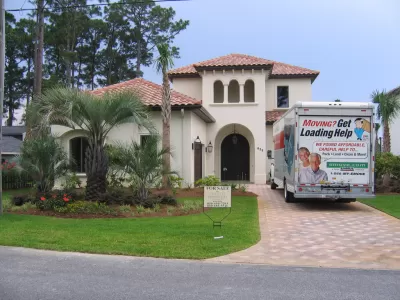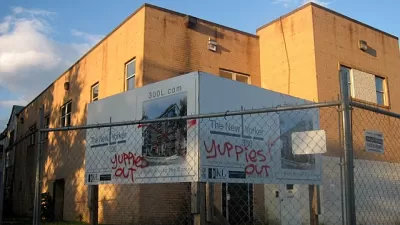Commentators often say an influx of wealth is transforming American cities. But if prosperity is really still suburban, what are the consequences for the environment?

Working from a Martin Prosperity Institute study on residential segregation, Ben Adler argues, "The gentrification trend in a handful of coastal cities has been blown way out of proportion by journalists who happen to live there, when far more urban neighborhoods remain mired in poverty."
"This is bad news for the environment. The constant push to expand the urban periphery paves over undeveloped land and requires carbon-intensive activities, from cutting down trees to mixing asphalt. Once they get to the suburbs, people consume more energy to heat and cool their larger, detached homes, water their bigger lawns, and drive more frequently and farther."
Adler points out that the urban rebirth hypothesis confuses city and metro area statistics: actual city residents remain poorer than their suburban neighbors. From the article: "In addition to the suburb-versus-city segregation, suburbs are themselves typically more economically segregated than cities, because they do not offer as wide a variety of housing types. A suburban town that requires each house to sit on its own lot of no less than, say, one-quarter of an acre, makes all the housing unaffordable to low-income workers."
The article also calls attention to non-resident visitors, a source of diversity that suburbs often lack. "Another way you will see more diversity in those New York neighborhoods is that you will encounter people in them, such as shoppers and workers, who do not live there. As [Richard] Florida readily agrees, measuring residential segregation only tells part of the story of what people experience in their daily lives."
FULL STORY: No, the rich are not all moving to the city now

Alabama: Trump Terminates Settlements for Black Communities Harmed By Raw Sewage
Trump deemed the landmark civil rights agreement “illegal DEI and environmental justice policy.”

Study: Maui’s Plan to Convert Vacation Rentals to Long-Term Housing Could Cause Nearly $1 Billion Economic Loss
The plan would reduce visitor accommodation by 25% resulting in 1,900 jobs lost.

Why Should We Subsidize Public Transportation?
Many public transit agencies face financial stress due to rising costs, declining fare revenue, and declining subsidies. Transit advocates must provide a strong business case for increasing public transit funding.

Paris Bike Boom Leads to Steep Drop in Air Pollution
The French city’s air quality has improved dramatically in the past 20 years, coinciding with a growth in cycling.

Why Housing Costs More to Build in California Than in Texas
Hard costs like labor and materials combined with ‘soft’ costs such as permitting make building in the San Francisco Bay Area almost three times as costly as in Texas cities.

San Diego County Sees a Rise in Urban Coyotes
San Diego County experiences a rise in urban coyotes, as sightings become prevalent throughout its urban neighbourhoods and surrounding areas.
Urban Design for Planners 1: Software Tools
This six-course series explores essential urban design concepts using open source software and equips planners with the tools they need to participate fully in the urban design process.
Planning for Universal Design
Learn the tools for implementing Universal Design in planning regulations.
Smith Gee Studio
Alamo Area Metropolitan Planning Organization
City of Santa Clarita
Institute for Housing and Urban Development Studies (IHS)
City of Grandview
Harvard GSD Executive Education
Toledo-Lucas County Plan Commissions
Salt Lake City
NYU Wagner Graduate School of Public Service





























